Dec-30-15
 | | Honza Cervenka: 17...Bxh2+ would be a mistake, as after 18.Kg2 it is white who attacks opponent's King via open h-file. 25.Bxc5 Bxc5 26.Qc3 Be7 27.Rd7 looks interesting. |
|
Jul-01-20
 | | KEG: A wild tactical battle. Plenty of mistakes, but some thrilling ideas and wild swings of fortune. Blackburne was entirely lost after his awful 36th move, and matters got worse from there. But Blackburne dragged on the game long beyond the point where most players would have called it a day. The explanation: At Vienna 1898, Blackburne saved a game against Tchigorin in which he was down a Queen and Rook. He apparently believed that he could work tactical magic (especially against Tchigorin) if he had any semblance of an attack. Going into this game, Tchigorin was still in competition for top honors. After winning this game, Tchigorin was in second place, half a point behind Janowski and ahead of von Scheve and Schlechter. Blackburne, meanwhile, was in a tail-spin, having lost his prior two games--one by forfeit because of Blackburne's indisposition. With this loss a later loss to Alapin, Blackburne finished in 7th place with an even score, after having been +3 a few rounds earlier. 1. d4 d5
2. Nf3 Nf6
3. e3 e6
4. a3

click for larger viewA novelty at the time, and consistent with Blackburne's penchant for unusual opening moves. 4... Bd6
4...c5 looks natural here, but the text is certainly reasonable. With this move, a unique opening position had been reached--by move 4! 5. c4
So we have a sort of QGD.
5... c6
A form of Slav?
5...0-0 or 5...b6 are the moves that spring to mind, but the text was not in any sense bad. 6. Nc3 Nbd7
7. Bd3 0-0
8. 0-0

click for larger view8... Qc7
8...dxc4 or 8...h6 would seem to yield an approximately even game. The text, while arguably not best, set the tone for much of what follows; the theme being the double-barreled attack on White's h2 pawn. The climax of this idea would emerge on moves 15-17. 9. Bd2
Clearing the way for play on the c-file, while by-passing the chance to break up Black's Queen/Bishop battery on the b8...hs diagonal with 9. c5. Tchigorin did not give Blackburne a second chance. 9... dxc4
10. Bxc4 e5
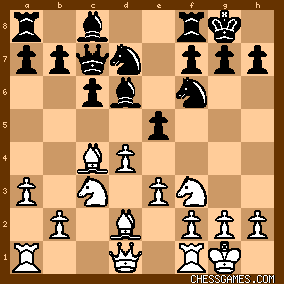
click for larger view11. dxe5
Pretty much relinquishing any advantage he had enjoyed as White. 11. Rc1 seems indicated here. 11... Bxe5
Perhaps only Tchigorin of top players would have played this rather than the seemingly obvious 11...Nxe5. Preferring Knights to Bishops, Tchigorin hardly feared 12. NxB. 12. Qc2 Bd6
13. Rad1 Nb6
One might have expected Tchigorin to initiate some sort of minority attack on the Queen-side with 13...a5 or 13...b5. 14. Ba2
14. Be2 and 14. Bd3 look like better choices for this Bishop. 14... Bg4
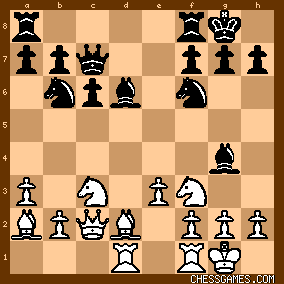
click for larger viewApparently logical play by Tchigorin: attacking the Knight defending h2. But--as Blackburne quickly demonstrated--there is more to this position than immediately meets the eye. Theoretically, chances are even. Over the board, however, the position is awash with all sorts of tactical possibilities and snares for the unwary. |
|
Jul-02-20
 | | KEG: Post II
15. Ne4
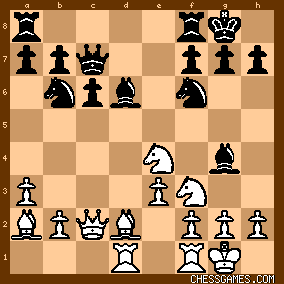
click for larger viewThis move was not in my mental database when I first played over the game. Doesn't White just lose a pawn? Of course, Blackburne could also have just played 15. h3. But the text was in fact quite clever, and had a hidden point: 15... NxN
16. QxN BxN
17. gxB
17. QxB? Bxh2+ 18. Kh1 Be5 would clearly be bad for White? But isn't the text even worse, the position now being: 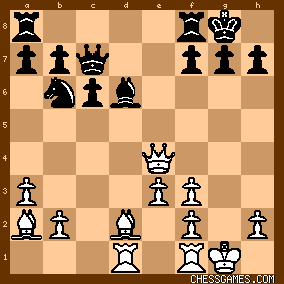
click for larger view17... Rae8
What about just playing 17...Bxh2+? Actually, that is exactly what Blackburne was hoping Blackburne would play: "It would have been a mistake to take the pawn and open the h-file for White." (Tournament Book) "17...Bxh2+ would be a mistake, as after 18. Kg2 it is White who attacks [the] opponent's king via [the] open h-file." (<Honza Cervenka>) I had missed this in my original thinking. But is all this really so bad for White? Let's see: 17...Bxh2+ 18. Kg2 Rfe8 [or 18...Rae8] 19. Qc2 Re5 20. Rh1 [20. f4 would lead to perpetual check after Black sacrifices Rook and Bishop--20...Qc8 (or 20...Qd7) 21. fxR Qg4+ 22. KxB Qh4+ 23. Kg2 Qg4+] Rg5+ 21. Kf1 Rh5 22. Bc3 resulting in a wild position in which White, though a pawn down, has a strong attack probably worth at least a pawn. Conclusion: 17...Bxh2+ would not have been a losing move, but it would have subjected Black to a strong attack well worth the sacrificed pawn and busted pawn structure. Thus, Tchigorin's decision to forego the chance to win a pawn was sound, though Black will likely survive in the above variations. 18. Qh4
As a result of Tchigorin's last move, Blackburne didn't have an open h-file on which to operate, but he was still determined to attack Tchigorin's King-side. The text, of course, also defended the pawn on h2. 18. Qc2 (again daring Black to play Bxh2+) was another good option for White. 18... Kh8
Tchigorin had seen Blackburne's tactical prowess before, and hastened to organize a King-side defense. But 18...Be5 was a much better means of fending off Blackburne's plans and seems to lead to approximately even chances. After 18...Kh8, the position was:
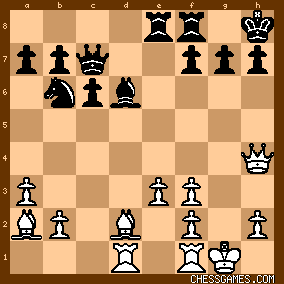
click for larger view19. e4
Blackburne wanted to bring his dark-square Bishop into play, but this was not the best way to do so. White would definitely be better after 19. Ba5 or 19. Bc3 or---perhaps better still--19. f4 19... Nd7?
Tchigorin is unrecognizable at times in this game. He could have used the respite provided by Blackburne's last move to play 19...Be5 or 19...c5 or perhaps even 19...f5. The text gave Blackburne a chance to re-charge his attack, which he didn't miss: 20. f4!

click for larger viewOffering a pawn to fuel his attack. Should Tchigorin have taken the bait? |
|
Jul-02-20
 | | KEG: Post III
20... Nc5?
Tchigorin could--and should--have taken the e-Pawn. He would then have faced a serious attack,and it would have cost him the exchange, but this was better than the alternatives: e.g., 20...Rxe4 21. Bb1 Nf6 [the Rook obviously can't move in light of the mate threat on h7] 22. BxR NxB 23. f5 Nf6 after which Black has a pawn for the exchange and White's King-side is busted. White still has the better chances, but Black would definitely have been in the game. If Tchigorin didn't fancy 20...Rxe4, he might have tried 20...Nb6 or 20...Be7. The text could easily have cost him the game. 21. e5! Be7
22. Qh3 f5
A sad necessity.

click for larger view"Black is not afraid to give White a passed pawn for the ending." (Tournament Book) What game were they watching?
Black was obviously in trouble here, both in the middle game and in any resulting endgame (in light of White's protected passed pawn). Blackburne could here have seized control with 23. b4 or 23. Be3. But he misjudged badly and played: 23. Bb1? Qc8
Suddenly, Tchigorin was back in the game.
24. Be3 g6
A questionable choice. He might have tried 24...Na4. After 24...g6, the position was:
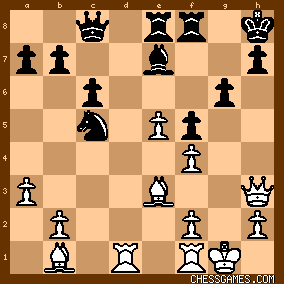
click for larger view25. Rc1
<Honza Cervenka> here found a fascinating line: 25. BxN BxB 26. Qc3 Be7 27. Rd7! This Rook sortie is possible since 27...QxR?? loses the Queen to 28. e6+. Assuming Black avoids this trap (e.g., 27...Bh4 28. Rfd1) White gets the better game, but no better than after the text (25. Rc1). 25... Ne6
26. Kh1
Weak. Blackburne could have maintained a significant advantage with 26. Ba2 or 26. Rfd1 or 26. Qh6. 26... c5!
27. Rg1 Qc6+
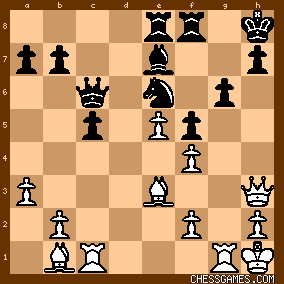
click for larger viewTo this point, Blackburne had enjoyed the edge for most of the game. But starting here, whether because of time trouble or otherwise, Blackburne ran his good position into the ground. 28. f3?
White would still have been better with 28. Qg2. The text, by contrast, mangled the coordination of his pieces, and created a weakness on his King-side to boot. 28... Rg8
29. Rg3
Another weak effort. 29. Ba2 was clearly best.

click for larger viewThanks to Blackburne's lackluster play, Black now had the better chances. |
|
Jul-02-20
 | | KEG: Post IV
29... Rg7
Missing the chance to play 29...c4 with excellent winning chances. 30. Rcg1
Once again missing a chance to play 30. Ba2.
30... Kg8
30...Rd8 was much better.
The last few moves may have been affected by time pressure (i.e., the move 30 time control). Now that time pressure was (at least temporarily) over, the position was: 
click for larger view31. Qg2 Rf8
32. Ba2
Having ignored two prior opportunities to play Ba2, Blackburne might here have tried 32. b3 or 32. Rc1. 32... c4!
Tchigorin begins operations on the Queen-side.
33. Qc2
33. Qe2 was better.
33... b5
"The Black pawns are becoming powerful." (Tournament Book) 
click for larger view34. b3
This allowed the Pawn on a3 to become a target, but I'm not sure that Blackburne had anything better. 34... Rc8
35. bxc4 bxc4
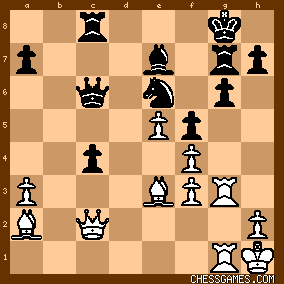
click for larger viewBlackburne's position at this point was clearly difficult, but was by no means lost. He did, however, have to defend his a3 Pawn with 36. Qc3 or 36. Qb2 or perhaps even 36. Ra1. Instead, Blackburne let it hang: 36. Rc1? Bxa3
Black now has two passed pawns on the Queen-side, and the game was probably already lost for Blackburne. 37. Rb1?
If the game was not lost before this lemon, it was lost now. 37. Rd1 was the best chance. 37... Kh8
Getting his King off the dangerous diagonal and trying to give Blackburne no counter-chances. 38. Qc3?
Digger an even deeper grave for himself.
38... Bf8
38...Bc5 was even stronger, but the text still yields am overwhelming position for Black. Tchigorin had a losing record against Blackburne (5 wins, 6 loses, and three draws) going into this game and--as previously noted--had lost a won game against him at Vienna 1898. He was trying to take no chances. The position after 38...Bf8 was:
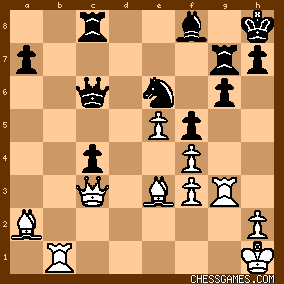
click for larger view"White has an inferior position because of the threat posed by the two passed pawns." (Tournament Book) In addition, Blackburne was down a pawn and had little counterplay. From here, Blackburne--desperately searching for some tactical magic--ran his already bad position further into the dust, but nonetheless dragged on the game for a very long time. |
|
Jul-03-20
 | | KEG: Post V
39. Rc1 Rgc7
40. h4?!
Desperate to create something on the King's side. As a practical matter, this probably was more promising than standing pat with "safer" and "sounder" moves such as 40. Qe1 or 40. Rc2 or 40. Qd2. 40... Qa4
40...Bc5 initiating the trade of a pair of Bishops was probably simpler. 41. Qd2
His best chance was the defensive/offensive 41 Rg2. 41... Qa3
This didn't ruin anything, but 41...Bh6 or 41...Rd8 was faster means of winning. After 41...Qa3 the position was:

click for larger view42. h5?!
Reckless, but Blackburne had little to lose by this point. 42. Rc2 might have prolonged the game, but it held little real chance of staving off defeat. 42... Rd8!
Blackburne might have called it a day at this point, but given his miraculous save of a dead lost position against Tchigorin at Vienna 1898, Blackburne was far from ready to lower his flag. 43. Qf2 Bc5!

click for larger view44. Re1 BxB
Tchigorin of course could have just played 44...Nxf4, but the text is simpler. 45. RxB

click for larger view45... Qc1+
45...Qe7! (threatening Qh4) would have been murder. 46. Re1?
Now it's sheer carnage. Blackburne had to play 46. Rg1 to have any chance at all. 46... Qxf4
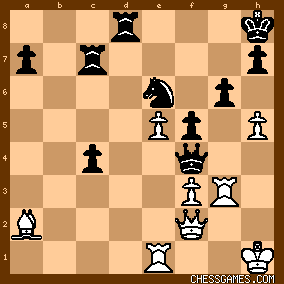
click for larger viewThis looks pretty gruesome for White. And it got (much) worse. Incidentally, the move 45 time control had been reached, so time pressure should not have been an issue. 47. Rg2
"The least bad move." (Tournament Book)
It is easy to understand the desire to protect against 47...Rd2, but this time the remedy was worse than the disease. If Blackburne wasn't ready to resign, he should have played 47. Rh3 or 47. Rgg1. 47... Rd3
Tchigorin played the balance of the game as if worried about Blackburne's ability to make something of nothing (shades of the debacle Tchigorin suffered against Blackburne at Vienna 1898). It is otherwise hard to explain why Tchigorin didn't just play the crushing 47...c3. If then 48. BxN, Black cruises home with 48...c2 49. Qg3 QxQ 50. RxQ Rd1 51. Rgg1 c1(Q) 52. RxR Qf4. 48. Rh2?!
Hoping for another miracle finish, and praying for some action on the h-file. But this sure looks entirely hopeless. 49. Qg3, though hardly likely to chance the outcome, looks like the only even slim reed of a chance. The sad White position after 48. Rh2?! was:

click for larger view |
|
Jul-03-20
 | | KEG: Post VI
48... Rxf3
This was plenty good, but 48...c3 was even more brutal (49. hxg6 Rd2 or 49. BxN c2 50 Rh4 c1(Q) 51. RxQ QxR). 49. Qg2
Still playing for a miracle King-side attack.
49... g5
Tchigorin was still seeing ghosts, and feared the opening of the h-file. To be sure, this move wins. But the immediate killer was 49...c3! I suspect that Tchigorin would have played this against just about anyone else. 50. h6?!
Still looking for a magic checkmate to turn the tide: 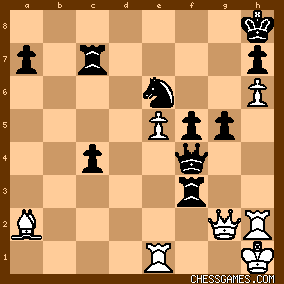
click for larger view50... Kg8
Running with his King just in case there was some miracle mate looming. Once again, advancing the c-pawn would have been a killer. 51. Bb1
Hope springs eternal (especially with Blackburne at the helm). 51... Kf7
Still running for the hills. 51...Rd7 or 51...Rc5 would have been faster. 52. Rh3
Hard to understand what Blackburne was thinking here. Now Tchigorin's fears evaporated, and he ran Blackburne off the board: 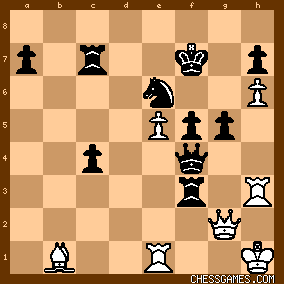
click for larger view52... Rf2
Game over, right? Nope. Blackburne played on.
53. Qa8 Rf1+
Bringing the other Rook to the party with 53...Rd7 was arguably faster, but the text was certainly conclusive (and would have induced resignation from just about anybody other than Blackburne. 54. RxR QxR+
55. Kh2
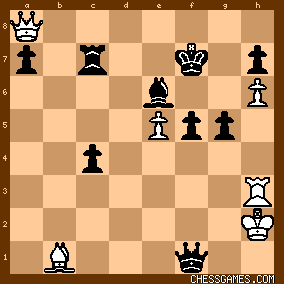
click for larger view55... Qf2+
Even Blackburne might have lowered his colors after 55...Rd7. The text was, at worst, a temporary stay of execution. 56. Kh1 Qe1+
57. Kh2 Qxe5+
Yet again, Rd7 was fastest. But the text also seemed more than adequate to end play: 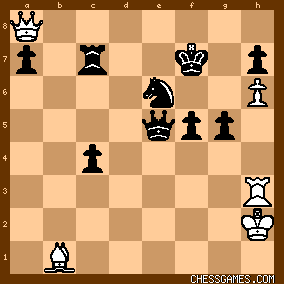
click for larger viewBelieve it or not, Blackburne played on here--according to the Tournament Book--for another seven moves. Those remaining moves, if indeed they were played, are mercifully lost to posterity. In any case, the result was long since obvious.
0-1 |
|
|
|
|





